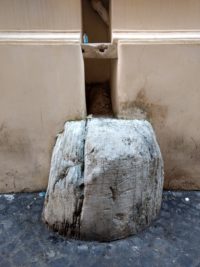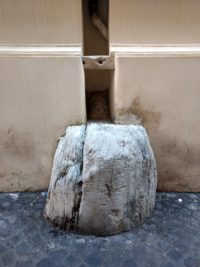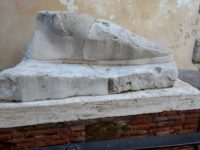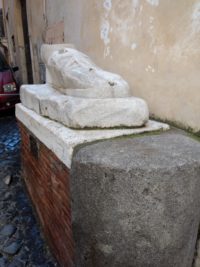This morning was all about the city of Rome as an easily accessible museum with no tickets to buy. After the de rigeur breakfast caffe’ at Sant’Eustachio, which, just by the by, is a miracle wondercoffee touched by the gods, it was off to see a couple of little things plopped in the middle of random alleyways in the centro storico. First up: a lump of marble with what looks like a cut in it. According to legend, that cut was put there by the Roland, knight of Charlemagne and hero of France’s national epic, the chanson de geste The Song of Roland. This is why the tiny, otherwise unremarkable alleyway is called Vicolo della Spada d’Orlando (Alley of the Sword of Roland).
There are actually two legends attendant this lump, both star not just Roland, but his trusty sword, Durendal. Durendal was the sharpest sword in the world and unbreakable because it was filled with the power of four relics: one tooth of Saint Peter’s, some blood from Saint Basil, a piece of the Virgin Mary’s robe and a hair from Saint Denis. Charlemagne had received it directly from an angel and gave it to his loyal warlord Roland.
Roland was fighting a Muslim ambush at Roncesvalles in northern Spain, slaughtering thousands with his great skill in combat and his unbreakable, sharpest of sharp sword. Even so, the Franks were tremendously outnumbered and when he saw that he was about to be overrun, Roland tried to destroy Durendal to keep such a powerful weapon out of their hands. He struck a powerful blow against a solid marble column. The sword did not break. It just cut the column instead. Roland would die at Roncesvalles from blowing his horn Oliphant, calling to Charlemagne’s forces that they avenge him. He blew so hard his temples exploded and his brains popped out. Somehow, the piece of marble with the cut in it made its way to a Roman alley. That niggling detail is not recorded in this iteration of the legend.
The second version cuts the whole mysterious transport of a column chunk out of the picture and instead simply declares that Roland was in Rome this one time. He was attacked and in defending himself against said attackers, he slashed vigorously in all directions at his many enemies, inadvertently cutting through a nearby column.
Now, it is reasonable that a whole column might have been in that wee streetlet, because the remains of a wall have been found there that once belonged the Temple of Matidia, a temple built by Hadrian in 119 A.D. dedicated to his mother-in-law Salonia Matidia, niece of Trajan. Almost none of that temple remains, but there are a couple of columns embedded into a palazzo at the end of the alley in Piazza Capranica. That Roland happened to be walking by only to be beset upon by foes and stabbed his invincible sword in the stone may be less reasonable but it’s even more awesome.
Amusing anecdote typical of Rome: there were three workmen lounging around at the entrance to the alley. They were very busily engaged in smoking in conversation. I bid them good morning and stepped between them to sidle into the Vicolo. One of them told me there was no entry. I pointed out that I had already entered, really, and only wanted to catch a glimpse of the Roland thingy. He was all “Eh. Might as well go through since you’re there.” AGREED, KIND SIR!
After all that ado, here is the mark of the spada d’Orlando, one as I found it with a tiny (empty) bottle of Bombay Sapphire gin on top, one as I left it, garbage removed.


The second stop on the random alleyway tour was Via del Pie’ di Marmo, Way of the Marble Foot. I wrote about that marble foot more than seven years ago when it got a shiny new pedicure transforming it from the gunky blackened thing I remembered from childhood to a clean white. The news accounts at the time said it had a new fence around it, and so it does, a simple black iron square band. It’s not as bright white as it was seven years ago, but frankly I think the lived-in look suits it better. I’m happy it got some attention amidst the unstoppable avalanche of work that always needs doing in so ancient a city.


If only the marble looked less like being prone to splitting naturally…
How many Roman workmen does it take to make an oxymoron?
It is just possible that there is a rock, old sculptural fragment or weathered Roman relic somewhere in Rime that DOESN’T have a local story attached to it…but I doubt it. 😉
From an Eastern Frankish point of view -apart from ‘Gallia Transalpina’- what we now refer to as “France” had hardly been invented. The Basques, however, were threatened by the Muslims as well by expanding Franks. Apparently, Charles had crushed the Saxons, “Ro[t]landus” was put in charge over Britanny, and then the Basques/ Muslims were accosted.
I have really no idea if and when “Ro[t]landus” visited Rome. In 800, however, when Charlemagne was there, he had obviously already been killed. In the Vita Karoli Magni (Einhardus) from ca. 810 it reads:
———–
“Adjubat in hoc facto Vascones et levitas armorum et loci, in quo res gerebatur, situs. Contra Francos et armorum gravitas et loci iniquitas per omnia Vasconibus reddidit impares. In quo proelio Eghartus, regiae mensae praepositus, Anshelmus, comes palatii, et “Rotlandus” britannici littoris (limitis) praefectus, cum aliis pluribus interficiuntur.”
———–
“It helped the Basques in that matter the lightness of their weapons as well as the nature of the chosen terrain. The Franks, contrastingly, were disadvantaged by their heavy weapons and the roughness of the location against the Basques in all aspects. In that skirmish, among many others, Eghart, overseer of the king’s table, Anshelm, palace count, and “Ro[t]landus”, prefect of the Bretonnic borderland, were slain.”
Love these kinds of little stories. They have no real truth but the kitch of it is always so much fun.